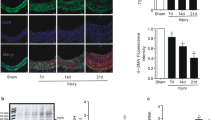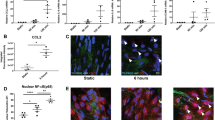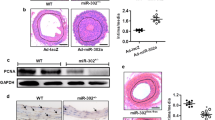Abstract
Patency of autologous human saphenous vein coronary artery bypass grafts (CABG) is compromised by intimal thickening and superimposed atherosclerosis, caused by migration of vascular smooth muscle cells (SMC) to the intima where they proliferate. Here, using adenoviral transfer, we have targeted SMCs using wild-type p53 (wt p53) overexpression. Initial in vitro analyses demonstrated that wt p53 overexpression had no effect on SMC proliferation but promoted apoptosis, which was inhibited by co-expression of bcl2 or crmA. Wt p53 inhibited SMC invasion through reconstituted matrices, a phenotype not affected by bcl2 or crmA. Overexpression of wt p53 in human saphenous vein before organ culture significantly induced apoptosis (P < 0.01, Student's t test) without affecting proliferation rates either in the media or in the intima. SMC migration was, however, significantly reduced by wt p53 (P < 0.01, Student's t test). Intimal thickening and the number of neointimal cells were reduced by 89% and 73%, respectively, after 14 days (P < 0.01 and P < 0.001, respectively, Student's t test). This study demonstrates that overexpression of wt p53 promotes apoptosis and inhibits migration of SMC leading to reduced intimal thickening. This maybe a useful approach for increasing patency rates in CABG procedures in the clinic.
This is a preview of subscription content, access via your institution
Access options
Subscribe to this journal
Receive 12 print issues and online access
$259.00 per year
only $21.58 per issue
Buy this article
- Purchase on Springer Link
- Instant access to full article PDF
Prices may be subject to local taxes which are calculated during checkout







Similar content being viewed by others
References
Izzat M, West R, Bryan A . Coronary artery bypass surgery: current practice in the United Kingdom Br Heart J 1994 71: 382–385
Marwick C . Coronary bypass grafting: economics, including rehabilitation Curr Opin Cardiol 1994 9: 635–640
Campeau L et al. Atherosclerosis and late closure of aortocoronary saphenous vein grafts: sequential angiographic studies at 2 weeks, 1 year, 5 to 7 years and 10 to 12 years after surgery Circulation 1983 68: II–1s–II-7s
Bryan A, Angelini G . The biology of saphenous vein graft occlusion: etiology and strategies for prevention Curr Opin Cardiol 1994 9: 641–649
Davies M, Hagen P-O . Pathobiology of intimal hyperplasia: a review Eur J Vasc Surg 1995 9: 7–18
Baker A, Mehta D, George S, Angelini G . Prevention of vein graft failure: potential applications for gene therapy Cardiovasc Res 1997 35: 442–450
Cable D et al. The role of gene therapy for intimal hyperplasia of bypass grafts Circulation 1999 100: II–392–II-396
George SJ, Baker AH, Angelini GD, Newby AC . Gene transfer of tissue inhibitor of metalloproteinase-2 inhibits metalloproteinase activity and neointima formation in human saphenous veins Gene Therapy 1998 5: 1552–1560
George SJ et al. Adenovirus-mediated gene transfer of the human TIMP-1 gene inhibits SMC migration and neointima formation in human saphenous vein Hum Gene Ther 1998 9: 867–877
Mann MJ et al. Genetic engineering of vein grafts resistant to atherosclerosis Proc Nat Acad Sci USA 1995 92: 4502–4506
Mann MJ et al. Cell cycle inhibition preserves endothelial function in genetically engineered rabbit vein grafts J Clin Invest 1997 99: 1295–1301
Bai H et al. Inhibition of intimal hyperplasia after vein grafting by in vivo transfer of human senescent cell-derived inhibitor-1 gene Gene Therapy 1998 5: 761–769
George SJ et al. Inhibition of late vein graft neointima formation in human and porcine models by adenovirus-mediated overexpression of tissue inhibitor of metalloproteinase-3 Circulation 2000 101: 296–304
Mann M et al. Ex vivo gene therapy of human vascular bypass grafts with E2F decoy: the PREVENT single-centre, randomised, controlled trial Lancet 1999 354: 1493–1498
George SJ, Zaltsman AB, Newby AC . Surgical preparative injury and neointima formation increase MMP-9 expression and MMP-2 activation in human saphenous vein Cardiovasc Res 1997 33: 447–459
Steg P et al. Reduction of restenosis after angioplasty in an atheromatous rabbit model by suicide gene therapy Circulation 1997 96: 408–411
Guzman R et al. In vivo suppression of injury-induced vascular smooth muscle cell accumulation using adenovirus-mediated transfer of the herpes simplex virus thymidine kinase Proc Natl Acad Sci USA 1994 91: 10732–10736
Ohno T et al. Gene therapy for vascular smooth muscle cell proliferation after arterial injury Science 1994 265: 781–784
Katayose D, Wersto R, Cowan K, Seth P . Consequences of p53 gene expression by adenovirus vector on cell cycle arrest and apoptosis in human aortic vascular smooth muscle cells Biochem Biophys Res Commun 1995 215: 446–451
Yonemitsu Y et al. Transfer of wild-type p53 gene effectively inhibits vascular smooth muscle cell proliferation in vitro and in vivo Circ Res 1998 82: 147–156
Aoki M et al. Inhibition of the p53 tumour suppressor gene results in growth of human aortic vascular smooth muscle cells: potential role of p53 in regulation of vascular smooth muscle cell growth Hypertension 1999 34: 192–200
Bennett MR, Littlewood TD, Schwartz SM, Weissberg PL . Increased sensitivity of human vascular smooth muscle cells from atherosclerotic plaques to p53-mediated apoptosis Circ Res 1997 81: 591–599
Toschi E et al. Wild-type p53 gene transfer inhibits invasion and reduces matrix metalloproteinase-2 levels on p53-mutated human melanoma cells J Invest Dermatol 2000 114: 1–7
Soyombo AA et al. Intimal proliferation in an organ culture of human saphenous vien Am J Pathol 1990 137: 1401–1414
Ricconi T et al. Adenovirus-mediated wild-type p53 overexpression inhibits endothelial cell differentiation in vitro and angiogenesis in vivo Gene Therapy 1998 5: 747–754
Pierzchalski P et al. p53 induces myocyte apoptosis via activation of the renin-angiotensin system Exp Cell Res 1997 234: 57–65
Wilkinson GWG, Akrigg A . Constitutive and enhanced expression from the CMV major IE promoter in a defective adenovirus vector Nucleic Acids Res 1992 20: 2233–2239
Baker AH et al. Development of recombinant adenoviruses that drive high level expression of the human metalloproteinase-9 and tissue inhibitor of metalloproteinase-1 and -2 genes: characterization of their infection into rabbit smooth muscle cells and human MCF-7 adenocarcinoma cells Matrix Biol 1996 15: 383–395
Southgate K, Newby AC . Serum-induced proliferation of rabbit aortic smooth muscle cells from the contractile state is inhibited by 8-Br-cAMP but not 8-Br-cGMP Atherosclerosis 1990 82: 113–123
George S, Fabunmi R, Williams A, Newby A . An essential role for platelet derived growth factor in neointima formation in human saphenous vein in vitro Atherosclerosis 1996 120: 227–240
Pederson DC, Bowyer DE . Endothelial injury and healing in vitro Am J Pathol 1985 119: 264–272
Acknowledgements
We wish to thank Mr Jason Johnson and Miss Melanie Smith for technical assistance, Gary Nabel (University of Michigan) for RAdcrmA and Dr James Uney (University of Bristol) for RAdbcl2. The European Biomed2 initiative, the Garfield Weston Foundation, the British Heart Foundation and the Medical Research Council for Great Britain funded this work.
Author information
Authors and Affiliations
Rights and permissions
About this article
Cite this article
George, S., Angelini, G., Capogrossi, M. et al. Wild-type p53 gene transfer inhibits neointima formation in human saphenous vein by modulation of smooth muscle cell migration and induction of apoptosis. Gene Ther 8, 668–676 (2001). https://doi.org/10.1038/sj.gt.3301431
Received:
Accepted:
Published:
Issue Date:
DOI: https://doi.org/10.1038/sj.gt.3301431
Keywords
This article is cited by
-
Old blood from heterochronic parabionts accelerates vascular aging in young mice: transcriptomic signature of pathologic smooth muscle remodeling
GeroScience (2022)
-
Functional pathways associated with human carotid atheroma: a proteomics analysis
Hypertension Research (2019)
-
Inhibition of neddylation by MLN4924 improves neointimal hyperplasia and promotes apoptosis of vascular smooth muscle cells through p53 and p62
Cell Death & Differentiation (2018)
-
Carotid artery ligation induced intimal thickening and proliferation is unaffected by ageing
Journal of Cell Communication and Signaling (2018)
-
p55γ functional mimetic peptide N24 blocks vascular proliferative disorders
Journal of Molecular Medicine (2015)



